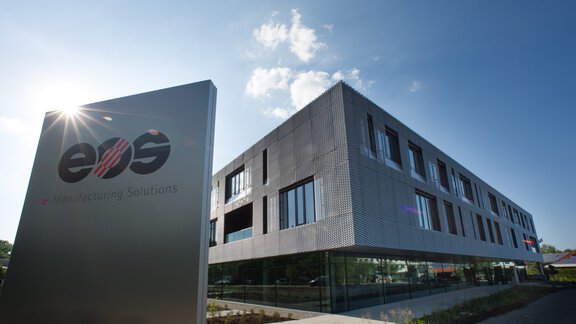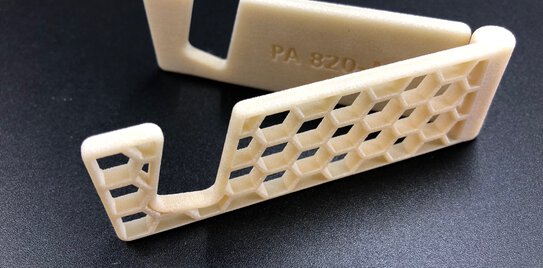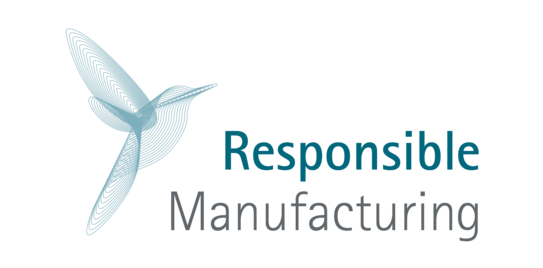Responsible 3D Printing with High-Performance Bio-Based Powder
At EOS, we are dedicated to improving the manufacturing process so that companies can reduce emissions, recycle more, and promote sustainability through setting a positive example. That’s why we have created a certified carbon neutral impact material solution for advanced additive manufacturing (AM).
100% renewable, zero net carbon
A carbon-neutral operation reduces a business’ carbon dioxide footprint so that emissions do not exceed the amount that is offset, creating a zero net emission for carbon dioxide. EOS and Advanced Laser Materials (ALM) — an EOS company — have achieved this with the polyamide 11 polymers thanks to a combination of the bio-based nature of the powder and the methodology of the material production.
The polyamide 11 powders were developed by Arkema, renowned as a pioneering innovator in castor-based high-performance polymers. With the help of ALM, Polyamide 11 powder solutions have been certified as carbon neutral. This is thanks to ALM’s additional steps to offset ancillary carbon generation by installing solar panels at their Texas headquarters and investing in Gold Standard carbon credits from the MyClimate solar project in Ethiopia.
Creating a bio-based powder from beans
The process for producing the PA11 powder begins simply with castor beans. This resource is an excellent candidate for producing polymer because it grows easily in India in marginal soil, is highly drought-resistant, and offers good profits for the farmers who grow it. Where other edible oils would not flourish in these same conditions, farmers are able to expand crops to supply the increased demand for castor beans brought about by the development of PA 11 powders. This has seen castor bean farming profiting more than half a million families in the areas it’s grown.
The castor beans are crushed to produce an oil, which resembles many standard vegetable oils. The oil is processed by Arkema to produce a monomer powder, which can then be further developed to create a polymer powder for injection molding and 3D printing.
To make the powder suitable for laser bed fusion printing required the expertise of ALM to formulate adjustments to the powder so that it will function properly in an AM system. ALM produces this powder under the name PA 820-MF CN. The material is available to purchase directly from EOS, it is suitable for use with the EOS P 396 and EOS P 770.
Uncompromising on performance
PA 11 powders are made to an exceptional standard. The powders have been recognized worldwide for their superior properties and performance in terms of toughness, durability, lightweight and processing versatility.
Due to their durability, these materials can be used for a wide range of projects. Not only are they used for standard lifestyle products, but they can also be used for automotive and aerospace applications
Sustainability through durability
Bio-based powders are designed purposely to be robust and long lasting. While they are not biodegradable like many oil-based polymers, the inherent durability of the material makes them an ideal choice for producing parts that are required to remain operational for a long period of time without the risk of decomposition, as seen with many biodegradable materials.
The result of this change in materials used means that parts need to be replaced less frequently. As opposed to less robust materials, the use of the polyamide 11 powder reduces production requirements and subsequently continues to have a positive impact on the environment as less parts depreciate and need to be discarded.
Dedicated to responsible manufacturing
Together with our partners, we strongly focus on establishing responsible manufacturing as the new normal. This material combines a sustainable feedstock from castor beans, with advanced performance characteristics and a carbon-neutral climate change profile.
The innovative polyamide 11 is the first carbon neutral, 100% bio-based powder we provide. We are continuing to do research on powders based on other natural oils and their potential for a wider range of materials in the future. But, as made evident from the process of creating polyamide 11, to fully achieve the most responsible methods of manufacturing possible requires a combination of changes across multiple areas in the field. That’s why, we are also optimizing the hardware of our 3D printing systems and working on process parameters to improve the refresh rate of the material used.
A better refresh rate will mean that less of the “non-fused powder” (the powder in the printer that doesn’t become part of the final product) can be reused for subsequent prints. This will further reduce waste and ensure an improved ratio of final production to powder, reflecting the EOS philosophy of continuing to drive toward more responsible manufacturing through advancements in 3D printing.





